#queen jane seymour
Text


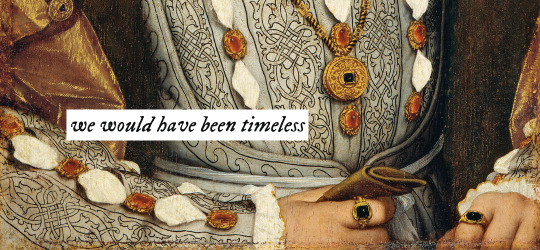
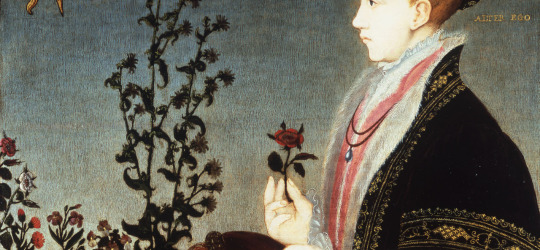
“In death, Jane became the ultimate consort; unblemished (especially in the eyes of her capricious and tyrannical husband), ever young, and the mother of a surviving son. Instead of merely being the wife who ‘died’ and in recognition of her saint-like life — which went beyond the medieval ideal of saintly queenship — Jane should actually be remembered as the wife who was (effectively) canonised.”
Aidan Norrie, ‘Jane Seymour: Saintly Queen’, Tudor and Stuart Consorts: Power, Influence, and Dynasty (Queenship and Power)
#jane seymour#henry viii#tudor history#edward vi#shoutout to machiavellianjane for posting the quote originally!#history#queen jane seymour#lyric cred is timeless by taylor swift ... obviously
196 notes
·
View notes
Text

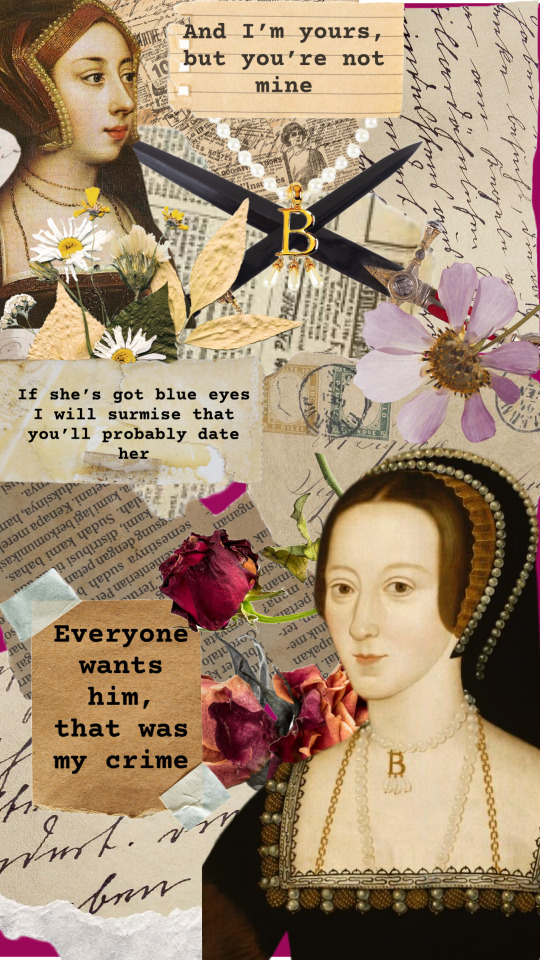


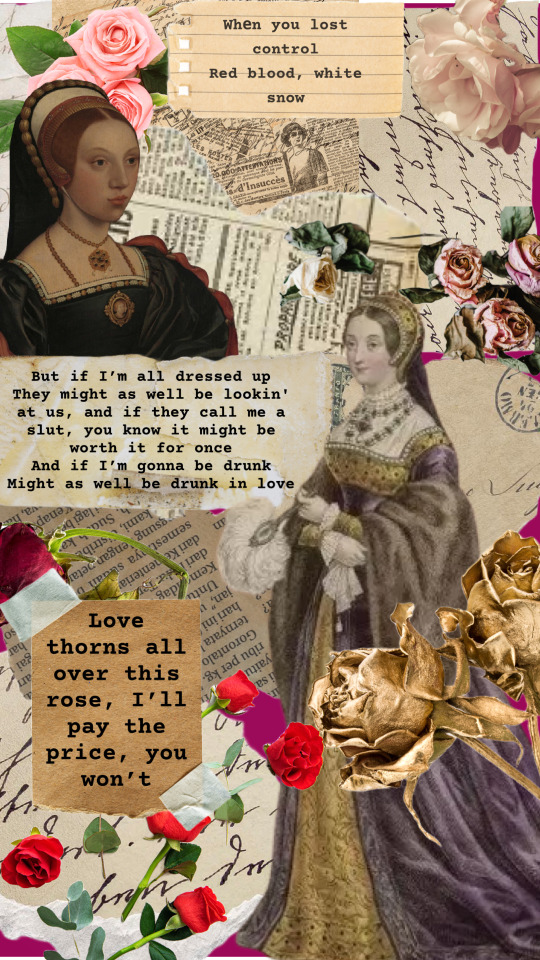

Six Wives of Henry VIII Collages using Lyrics from the Vault
#catherine of aragon#katherine of aragon#catalina de aragon#anne boleyn#queen anne boleyn#jane seymour#queen jane seymour#anne of cleves#anna of cleves#anna von kleve#katheryn howard#kathryn howard#katherine howard#catherine howard#katherine parr#kathryn parr#catherine parr#taylor swift#tudor history#the tudors#english history#tudor era#1989#1989 tv#1989 taylor's version#say don't go#is it over now?#suburban legends#now that we don't talk#slut!
128 notes
·
View notes
Text



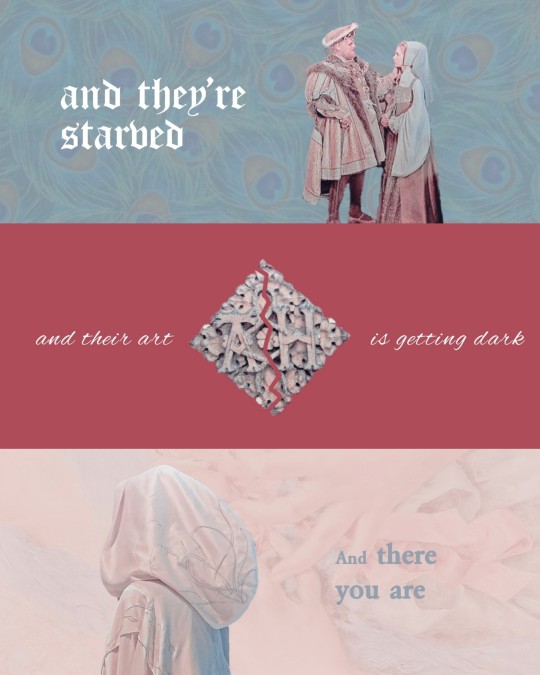
He hath come to the bosom of his beloved
Smiling on him, she beareth him to highest heaven
With yearning heart
On thee we gaze
Oh, gold winged messenger of mighty gods
[...]
You better keep your head down-down
- Billie Eilish, GOLDWING
#this song always reminds me of her like it all fits way too perfectly#the third slide is supposed to be the last one following the order of the lyrics. it's just there because it looked better in that position#jane seymour#jane seymour edit#queen jane seymour#wolf hall#the tudors#henry viii and his six wives#anita briem#my edits#perioddramaedit#graphics#graphic edit#filter by crownedfilter in ig#tudor queens
56 notes
·
View notes
Text

Hello!
This new account of mine is dedicated to Queen Jane Seymour and it's also a independent roleplay account. I'd love to roleplay with you. Don't hesitate to ask or say something. <3
I'm Jane Seymour, King Henry VIII's third wife and mother to King Edward VI.

#henry viii#the tudors#jane seymour#becoming elizabeth#elizabeth tudor#six the kids#edward tudor#annabelle wallis#jonathan rhys meyers#edward vi#queen jane seymour#roleplay#tudor#catherine of aragon#catherine parr#anne boleyn#elizabeth i#mary i#anne of cleves#henry tudor#katherine parr#katherine howard#rp#the six wives of henry viii
18 notes
·
View notes
Text
I really like the fact that in the Broadway version of "Six! The Musical" When it came to the second to last song, they changed "our family" to "my family" for Jane Seymour because this implies that she left Henry, took their son and met a better guy. A guy that didn't care if she gave him sons or daughters but just as long as they were happy and healthy. Yes, she was the devoted one, but her song states that Henry didn't really care about her even though she was the one he truly loved. Someone on here created a post as to why he probably didn't love her. Even if she had lived, he would have still found other wives in order to gain sons. He did have mistresses as well. Then, as stated by Jane in the second to last song, she'll form a family band, become famous, and then soon fade into obscurity up until she meets up with five of the wives and they create a pop group that will include Katherine Parr as well. It's most likely that Henry would have only wanted his sons to be in their family band and not the daughters.
10 notes
·
View notes
Text
Anne and Catherine the day after Easter:
Catherine walking into the room: hey Anne have you seen my Easter basket?
Anne: *has her back facing Catherine*
Catherine: I’ve been cravings my chocolate bunny all day!!
Anne: *still has her back facing Catherine and staying quiet*
Catherine: Anne what are you doing? turn around.
Anne: *with chocolate all over her face* I’m so sorry Catherine I ate your chocolate bunny.
Catherine: WHAT! ANNE WHY DIDN’T YOU EAT YOUR OWN CHOCOLATE BUNNY?
Anne: *now crying* I did last night which is why I had yours today. I’m so sorry Catherine.
Catherine: it’s ok Anne I’ll just go eat Janes
Anne: can we half it?
Catherine: ……yes
#anne boleyn#queen anne boleyn#catherine parr#queen catherine#jane seymour#Queen Jane Seymour#queen things#six the musical incorrect quotes#six the musical#incorrect six quotes#six queens#six incorrect quotes#incorrect quotes#catherine of aragon#anne of cleves#katherine howard#happy easter#easter#anne boylen#the six wives of henry viii#six wives of henry viii#anne boleyn edit#catherineparredit#natalie dormer#andrea macasaet#joely richardson#anna uzele#abby mueller#annabelle wallis#anita briem
22 notes
·
View notes
Photo

Queen Jane Seymour. By Henry Bone.
53 notes
·
View notes
Text
QUEEN JANE SEYMOUR
JANE SEYMOUR
c.1508-1537
THIRD WIFE OF HENRY VIII, MOTHER OF EDWARD VI
Seymour was maid-of-honour to Queen Catherine of Aragon as well as to Henry VIII’s second wife, Anne Boleyn.
During his marriage to Boleyn, Henry VIII fell in love with Jane due to her gentle and peaceful nature. Seymour’s brothers Edward and Thomas were both rising stars at court and encouraged the union. She had been ‘well tutored’ and the brothers warned Seymour not to give into Henry’s advances ‘unless he makes her his queen’. Seymour received great presents from the king and wore a locket of a picture Henry around her neck. Seymour opened and closed the locket whenever she was around Boleyn. Infuriated, Boleyn violently ripped it from her neck.
Boleyn only gave birth to a surviving girl and Henry quickly grew tired of Boleyn during their marriage. Boleyn who was pregnant with a son miscarried when she caught Seymour sitting on Henry’s knees. Boleyn was executed in 1536 for treason, that same day Henry VIII got engaged to Seymour. Ten days later they were married at Whitehall Palace. Jane sat under the canopy of estate in the presence chamber, some were taken aback ‘within one and the same month that saw Queen Anne flourishing, accused, condemned and executed, another was assumed into her place, both of bed and honour’.
Henry refused to crown her queen until she gave birth to a male heir. Seymour’s court was tame compared to Boleyn’s, Boleyn’s court was fun and entertaining,; however Seymour’s was strict, formal and conservative and she also banned the French fashion (which was in fashion when Boleyn was queen). Jane’s motto was ‘obey and serve’.
Seymour was against Henry’s dissolution of the monasteries and got down on her knees and begged to save them. Henry VIII reply was brutal and reminded her what happened to his last wife. Jane never interfered in politics again.
Seymour helped Henry to reconcile with his daughter Mary, and the two became good friends. When Seymour became pregnant she had constant cravings for quail which Henry ordered in for her. Seymour gave birth to a son, Edward (Edward VI) in 1537. He was christened a few days later, Seymour didn’t attend but Henry’s daughters, Mary and Elizabeth carried Edward’s train during the ceremony.
Seymour died from postnatal complications two weeks later aged 28 (or 29). She was buried in St. George’s Chapel at Windsor Castle and Mary was the chief mourner. Seymour was the only wife of Henry’s to receive a queen’s funeral. After she died, Henry wore black for the next three months, but ‘framed his mind’ to marry again for the good of his realm. When Henry VIII died in 1547 he was buried next to her at his request.
Seymour’s brothers continued to control and influence Edward VI, but both men lost their lives on the executioner’s block on Edward’s orders. Edward only ruled for six years before he died of illness. After Lady Jane Grey and Queen Mary I, it was Boleyn’s daughter Elizabeth I who became queen.

#janeseymour #queenjaneseymour #thetudors #henryVIII
2 notes
·
View notes
Photo

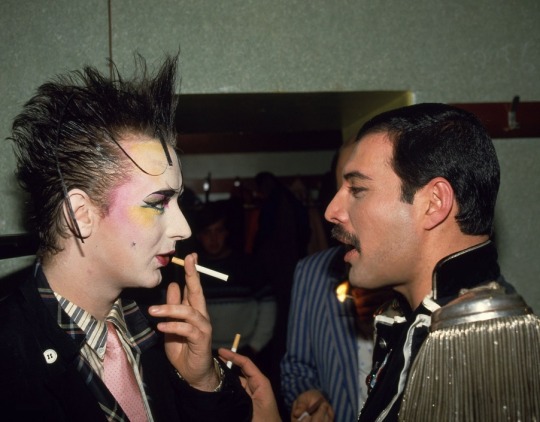
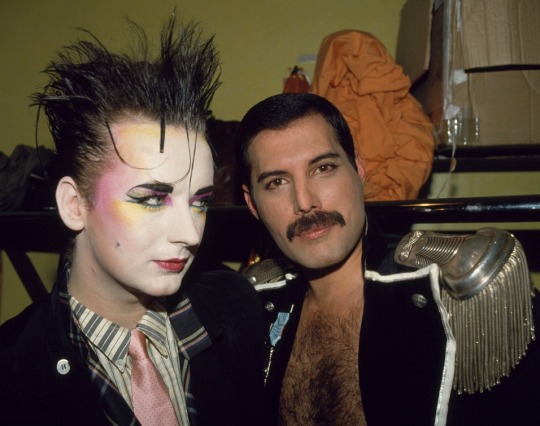
Freddie Mercury, Jane Seymour and Boy George at the Fashion Aid event at the Royal Albert Hall in London on November 5, 1985.
Photos by Duncan Raban
#freddie mercury#jane seymour#boy george#queen#culture club#1985#1980s#1980s music#1980s fashion#pop culture
3K notes
·
View notes
Text
random thought bc I've been listening to Six on repeat: the queens claim that the only reason they're remembered is because of Henry, but would Henry be one of the most iconic and well-known English monarchs if not for them?
#like his defining trait is sorta 'bloke who had six wives who he treated pretty badly all told' plus the whole church of england thing#which arguably would have happened anyway in some sense since protestantism was sweeping europe but is generally credited to him wanting#a divorce whether thats accurate or not#yes he was quite charismatic etc but there were plenty of others who were too or at least interesting#like nobody talks about the guy who was Probably murdered in a framed hunting accident#or the one who was executed by having a red hot poker rammed up his arse#or the one who dies after gorging himself on strawberries and eel pie iirc#ok fine maybe i only remember the memorable daeths but you get the point#the six wives are what made henry viii significant is what i'm saying#via shitposts#six#six the musical#tudors#tudor queens#catherine of aragon#anne boleyn#jane seymour#anne of cleves#katherine howard#catherine parr#henry viii
241 notes
·
View notes
Text
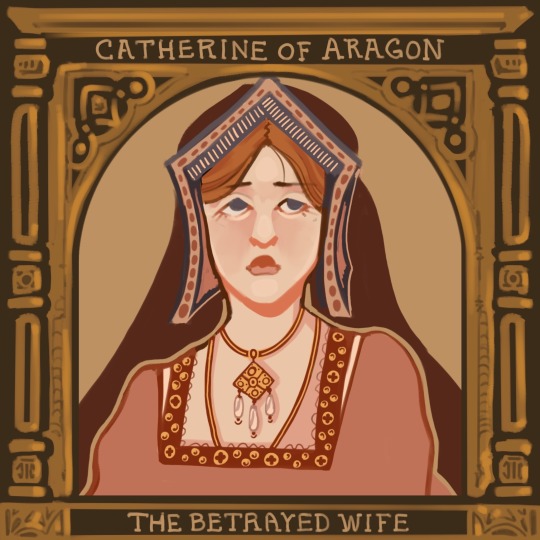



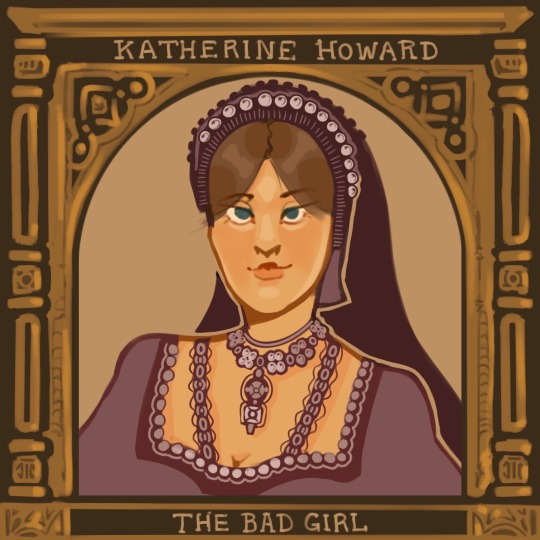

1. Catherine of Aragon (married 1509-1533)
motto: HUMBLE AND LOYAL
Even allowing for tactful hyperbole, it is clear that Catherine, […] did have the kind of youthful prettiness and freshness of appearance that charmed observers, not only the family into which she would marry. It was partly a question of her complexion: her naturally pink cheeks and white skin were much admired in an age when make-up was clumsy in execution, easy to detect and much scorned. Ambassadors abroad, describing princesses to their masters, generally emphasized the tint of the skin, carefully noting whether it was 'painted' or not. A fair complexion like Catherine's was thought to indicate a more serene and cheerful temperament than a 'brown' one. Then Catherine's hair was also fair and thick, with a reddish-gold tint, her features neat and regular in a pleasingly shaped oval face.
Perhaps Catherine's fair colouring, so far from the conventional picture of a dark-visaged Spaniard, reminded onlookers of her one-eighth of English blood: […] 'there is nothing wanting in her that the most beautiful girl should have. '
If her complexion was her chief beauty, Catherine's chief disadvantage was her lack of height. All the grace of her bearing, inculcated over many years at the Castilian court, could not conceal the fact that she was extremely short, even tiny. Years later a loyal defender had to admit that she was 'in stature somewhat mean', while adding quickly 'but bonarly [bonnie] withal'. She was also on the plump side - but then a pleasant roundness in youth was considered to be desirable at this period, a pointer to future fertility. In contrast Catherine's voice was surprisingly low and 'big-sounding' for a woman; and that no doubt contributed to the impression of gracious dignity she left on all observers, making up for the lack of inches.
2. Anne Boleyn (married 1533-1536)
motto: THE MOST HAPPY
Anne Boleyn was not a great beauty. The Venetian ambassador […] pronounced her 'not one of the handsomest women in the world'. […] Anne Boleyn was only moderately pretty.
Some of this lukewarm praise may have been due to the fact that her looks did not accord with the fair-haired, blue-eyed ideal of the time. In theory, dark looks were regarded with suspicion and Anne Boleyn's looks were conspicuously dark: she was 'Brunet' […] Anne Boleyn's olive complexion’ […] her colouring 'rather dark' or sallow 'as if troubled with jaundice', or 'not so whitely as ... above all we may esteem.' She did have a few moles, although she was hardly disfigured by them on the contrary they acted as beauty-spots. Her hair, thick and lustrous as it might be, was extremely dark […] And her eyes were so dark as to be almost black. But then the theory of public admiration was one thing - blondes were supposed to be of cheerful temperament - and the practice of physical attraction was quite another. Clearly in adulthood Anne Boleyn exercised a kind of sexual fascination over most men who met her; whether it aroused desire or hostility, the fascination was there.
The black eyes were sparkling and expressive; and they were set off by those 'dark, silky and well-marked eyebrows' […] on the subject: she knew well how 'to use [her eyes] with effect', whether deliberately leaving them in repose or using them to send a silent message which carried ‘the secret testimony of the heart'. As a result many became obedient to their power. More prosaically, the Venetian ambassador called her eyes "black and beautiful'. Her mouth, described by him as 'wide' (another theoretical disadvantage by the standards of the time), was recorded by Sander as pretty. […] Anne Boleyn was 'of middling stature' (which made her of course a great deal taller than Queen Catherine). She seems to have been quite slight or at any rate not full-breasted - the Venetian ambassador remarked that her bosom was 'not much raised' […]. But a much more important aspect of her appearance when she first came to court was her elegant long neck; this, with the deportment she had learned in France […] gave her a special grace, especially when dancing, which no one denied.
The fresh young damsel had other qualities, some more obvious than others at the moment of her arrival back in England. She had 'a very good wit', wrote Cavendish in his Life of Wolsey, another source not prejudiced in Anne Boleyn's favour? The phrase, going beyond mere intelligence, carried with it connotations of spirit and adventurousness; in other words, Anne Boleyn was good company. Like many spirited people, she had another more impatient side to her: she would display on occasion a quick temper and a sharp tongue. But of these characteristics, deplored in a woman as much as skill at singing and dancing was prized, there was as yet no sign.
3. Jane Seymour (married 1536-1537)
motto: BOUND TO OBEY AND SERVE
From other sources, it seems likely that the charm of her character considerably outweighed the charm of her appearance: […] of middle statute and no great beauty. Her most distinctive aspect was her famously pure white complexion. Holbein gives her a long nose, and firm mouth, with the lips slighty compressed, although her face son a pleasing oval shape with the high forehead then admired (enhanced sometimes by discret plucking of the hairline) and set off by the headdresses of the time. Altogether, if Anne
Boleyn conveys the fascination of the new, there is a dignified but slightly stolid look to Jane Seymour, appropriately reminiscent of English medieval consorts.
But the predominant impression given by her portrait - at the hands of a master of artistic realism - is a young woman of calm good sense. And contemporaries all commented on Jane Seymour's intelligence: in this she was clearly more like her cautious brother Edward than her dashing brother Tom. She was also naturally sweet-natured (no angry words or tantrums here) and virtuous - her virtue was another topic on which there was general agreement. There was a story that she had been attached to the son of Sir Robert and Lady Dormer, a country neighbour, but was thought of too modest a rank to marry him; even if true, the tale brought with it no slur on Jane's maidenly honour. It was told more as a Cinderella story, where the unfairly slighted girl would go on to be raised triumphantly to far greater heights. Her survival as a lady-in-waiting to two Queens at the Tudor court still with a spotless reputation may indeed be seen as a testament to both Jane Seymour's salient characteristics - virtue and common good sense. A Bessie Blount or Madge Shelton might fool around, Anne Boleyn might listen or even accede to the seductive wooings of Lord Percy: but Jane Seymour was unquestionably virginal.
In short, Jane Seymour was exactly the kind of female praised by the contemporary handbooks to correct conduct; just as Anne Boleyn had been the sort they warned against. There was certainly no threatening sexuality about her. Nor is it necessary to believe that her 'virtue' was in some way hypocritically assumed, in order to intrigue the King […]. On the contrary, Jane Seymour was simply fulfilling the expectations for a female of her time and class: it was Anne Boleyn who was - or rather who had been - the fascinating outsider.
4. Anne of Cleves (married 1540-1540)
motto: GOD SEND ME WELL TO KEEP
Let us take the actual appearance of Anna of Cleves first: for this we are fortunate in having a first-hand description, written only a few days later by the French ambassador, Charles de Marillac, who was not prejudiced in either direction, towards her beauty or her ugliness. Anna of Cleves looked about thirty, he wrote (she was in fact twenty-four), tall and thin, 'of middling beauty, with a determined and resolute countenance.' The Lady was not as handsome as people had affirmed she was, nor as young […], but there was a steadiness of purpose in her face to counteract her want of beauty.
The 'daughter of Cleves' was solemn, or at any rate by English standards she was, and she looked old for her age. She was solemn because she had not been trained to be anything else and the German fashions did little to give an impression of youthful charm in a court in love as ever with things French, or at any rate associating them with fun and delight. […] Turning to Holbein's picture, one finds this solemnity well captured: a critic might indeed term it stolidity. Besides Wotton, in his report, had confirmed that Holbein, generally regarded as the master of the 'lively' or lifelike (not the flattering) in his own time, had indeed captured Anna's "image' very well.
Of course a beautiful young woman, however stolid or badly dressed, would still have been acceptable. Anna of Cleves was not beautiful, and those reports which declared she was were egregious exaggerations in the interests of diplomats […]. But was Anna of Cleves actually hideous? Holbein, painting her full-face, as was the custom, does not make her so to the modern eye, with her high forehead, wide-apart, heavy-lidded eyes and pointed chin.
There is indirect evidence that Anna of Cleves was perfectly pleasant-looking from the later years of Henry VIII. When Chapuys reported Anna of Cleves as rating her contemporary, Catherine Parr, 'not nearly as beautiful' as herself, this expert observer did not choose to contradict her; so that the boast was presumably true, or at least true enough not to be ridiculous.
5. Katherine Howard (married 1540-1542)
motto: NO OTHER WILL BUT HIS
No confirmed authentic picture of Katherine Howard survives. The fact that Katherine Howard is the only one of Henry VIII’s wives for whose appearance we must rely properly on contemporary descriptions, gives her career an appropriately evanescent quality. The same mistiness surrounds her date of birth. She was eighteen or nineteen when the King’s roving eye first fell upon her: that is, roughly thirty years younger than he was. […] Katherine was not only small, as Catherine of Aragon had been, but diminutive: parvissima puella – a really tiny girl. If King Henry was about thirty years older than Katherine, he must have been well over a foot taller. We need not speculate further about their respective weights. The French ambassador rated her beauty as only middling (the same phrase he had used for Anna of Cleves, incidentally), but he did praise her gracefulness, and he found much sweetness in her expression; her habit of dressing à la française (as opposed to Anna of Cleves’ Germanic fashions) no doubt commended itself to him.
Even if Katherine Howard was not a beauty, she must have had considerable prettiness and obvious sex appeal (as well as – or perhaps because of – her youth) since we know that she captivated the King instantly.
6. Catherine Parr (married 1543-1547)
motto: TO BE USEFUL IN ALL I DO
The woman who brought about this cheerfulness, the new Queen Catherine Parr, was herself never described by anyone as a beauty: even the term ‘of middling beauty’ used for both Anna of Cleves and Jane Seymour by Marillac was not applied in this case. ‘Pleasing’ and ‘lively’, ‘kind’ and ‘gracious’ were the most flattering epithets ascribed to her. It is true that a difference of age and status may have been responsible for this lack – widows of over thirty were not expected to be beauties – but when Anna of Cleves indignantly exclaimed that the new Queen was ‘not nearly as beautiful as she’, Chapuys, passing on the comment, did not see fit to contradict it.
Queen Catherine Parr’s only known authentic likeness, attributed to William Scrots, shows an amiable face rather than an intriguing one; the nose is short, the mouth small, and the forehead broad rather than domed in the way that contemporaries admired. Her hair was rather similar in colour to that of Catherine of Aragon: light auburn, tinged with what Agnes Strickland in the nineteenth century would call ‘threads of burnished gold’.
But if the new Queen Catherine was not a beauty, she was neither dull nor austere. She enjoyed dancing. […] She was well set up – the tallest of King Henry’s wives – and her height would have enabled her to cut a regal figure since her conception of her role as queen consort also included a great deal of ornate dressing-up.
Bibliography:
- Fraser, Antonia. The Six Wives of Henry VIII. New York Knopf, 1993.
#henry viii#princess catherine#catherine of aragon#anne boleyn#queen anne#jane seymour#anne of cleves#katherine howard#catherine parr#procreateart#digitaldraw#digitalillustration#renaissance#medieval#english history#monarchy#the tudors#king henry viii#quotes#illustration#england
139 notes
·
View notes
Text
Many of her garments were embroidered with naturalistic designs such as strawberry leaves - a typically English motif.
Are any examples still existing? In portraits, perhaps? Google gives me modern dresses embroidered w strawberries.
261 notes
·
View notes
Text



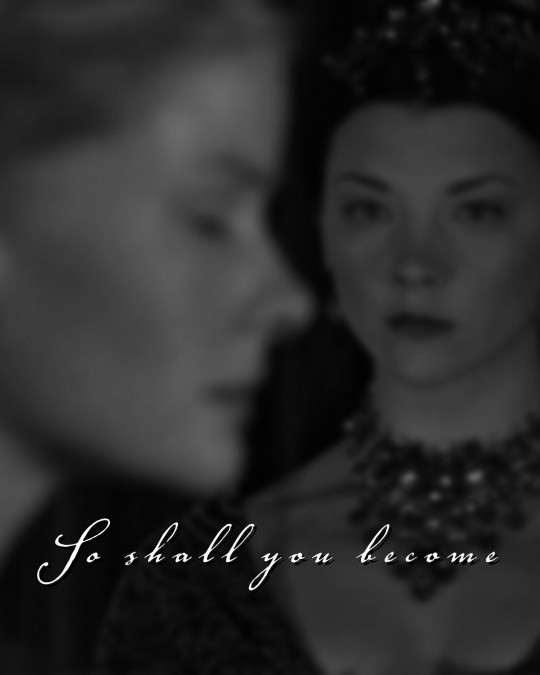
“As you are, so once was I. As I am, so shall you become…” Catherine x Anne parallels
#catherine of aragon#katherine of aragon#catalina de aragon#anne boleyn#queen anne boleyn#anna bolina#tudor history#henry viii#the tudors#english history#tudor era#jane seymour#queen jane seymour#tudor period#tudor england#house of tudor#tudor#tudors#edit#my edit#16th century#maria doyle kennedy#the spanish princess#charlotte hope#natalie dormer#anita briem#sixteenth century#british history#henry the eighth#henry viii of england
35 notes
·
View notes
Text
1500s:
Anne: Cousin Jane, thou shalt not open your mouth ever again if your only reason in doing so is to speak such foolishness.
Jane: I apologize, Cousin Anne, but I do not wish to lie to you, hence I will not make any promises I am not compelled to keep such as convincing thou that I will put a stop to my very much harmless behavior.
Nowadays:
Anne: Shut the fuck up.
Jane: Nah.
#english is not my first languagr#i do not know how to use those facy old words#but if its nessed ita alr#its supposed to sound stupid#jane seymour#anne boleyn#six the musical#six#six musical#six the memecal#six incorrect quotes#six the musical incorrect quotes#six queens#except its js two of em
66 notes
·
View notes
Text
it's not Henry VIII and his six wives
it's actually Catherine Of Aragon, Anne Boleyn, Jane Seymour, Anne Of Cleves, Catherine Howard and Catherine Parr
six women who were casually married to the same guy
#tudor queens#tudor dynasty#catherine of aragon#anne boleyn#jane seymour#anne of cleves#catherine howard#catherine parr#henry viii
69 notes
·
View notes
Text
If there is ever going to be a "Six! The musical movie Kelly Clarkson should be Jane Seymour! She has a strong voice, and she's made a few emotional songs over the years.
5 notes
·
View notes